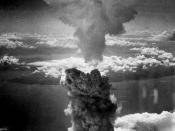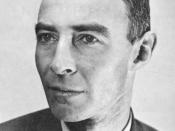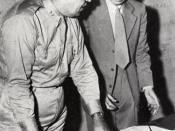On the morning of August 6, 1945, a B-29 bomber named Enola Gay flew over the industrial city of Hiroshima, Japan and dropped the first atomic bomb ever. The city went up in flames caused by the immense power equal to about 20,000 tons of TNT. The project was a
success. They were an unprecedented assemblage of civilian, and military scientific brain power--brilliant, intense, and young, the
people that helped develop the bomb. Unknowingly they came to an
isolated mountain setting, known as Los Alamos, New Mexico, to design
and build the bomb that would end World War 2, but begin serious
controversies concerning its sheer power and destruction. I became
interested in this topic because of my interest in science and
history. It seemed an appropriate topic because I am presently
studying World War 2 in my Social Studies Class. The Hiroshima and
Nagasaki bombings were always taught to me with some opinion, and I
always wanted to know the bomb itself and the unbiased effects that it
had. This I-search was a great opportunity for me to actually fulfill
my interest.
The Manhattan Project was the code name for the US effort
during World War II to produce the atomic bomb. It was appropriately
named for the Manhattan Engineer District of the US Army Corps of
Engineers, because much of the early research was done in New York
City (Badash 238). Sparked by refugee physicists in the United
States, the program was slowly organized after nuclear fission was
discovered by German scientists in 1938, and many US scientists
expressed the fear that Hitler would attempt to build a fission bomb.
Frustrated with the idea that Germany might produce an atomic bomb
first, Leo Szilard and other scientists asked Albert Einstein, a
famous scientist during that time, to use...



Interesting, Detailed & Relevant!
I really like this essay. I have always been interested in the Hiroshima & Nagasaki Atomik Bombings, this essay provides detailed & relevant information, without sounding like a boring histiry text book!
0 out of 0 people found this comment useful.